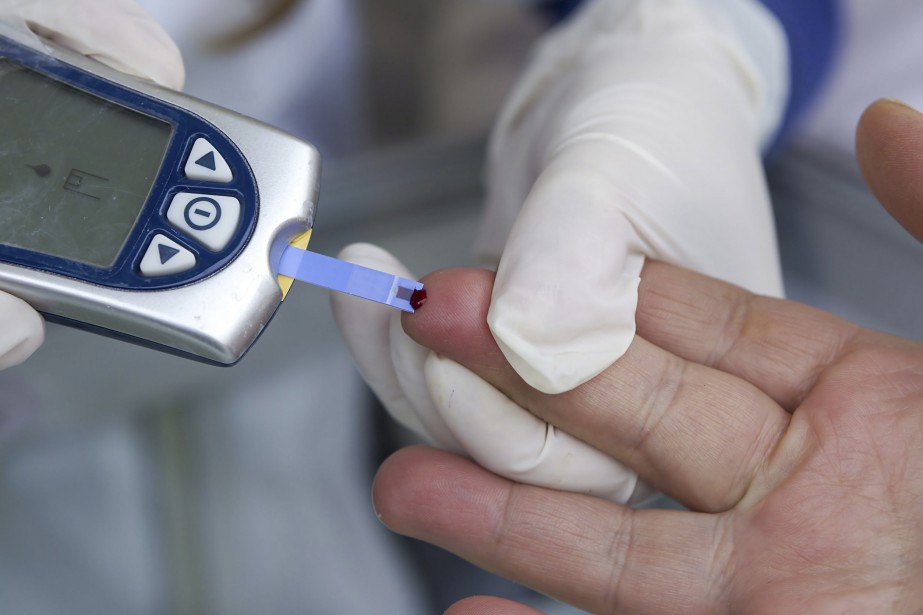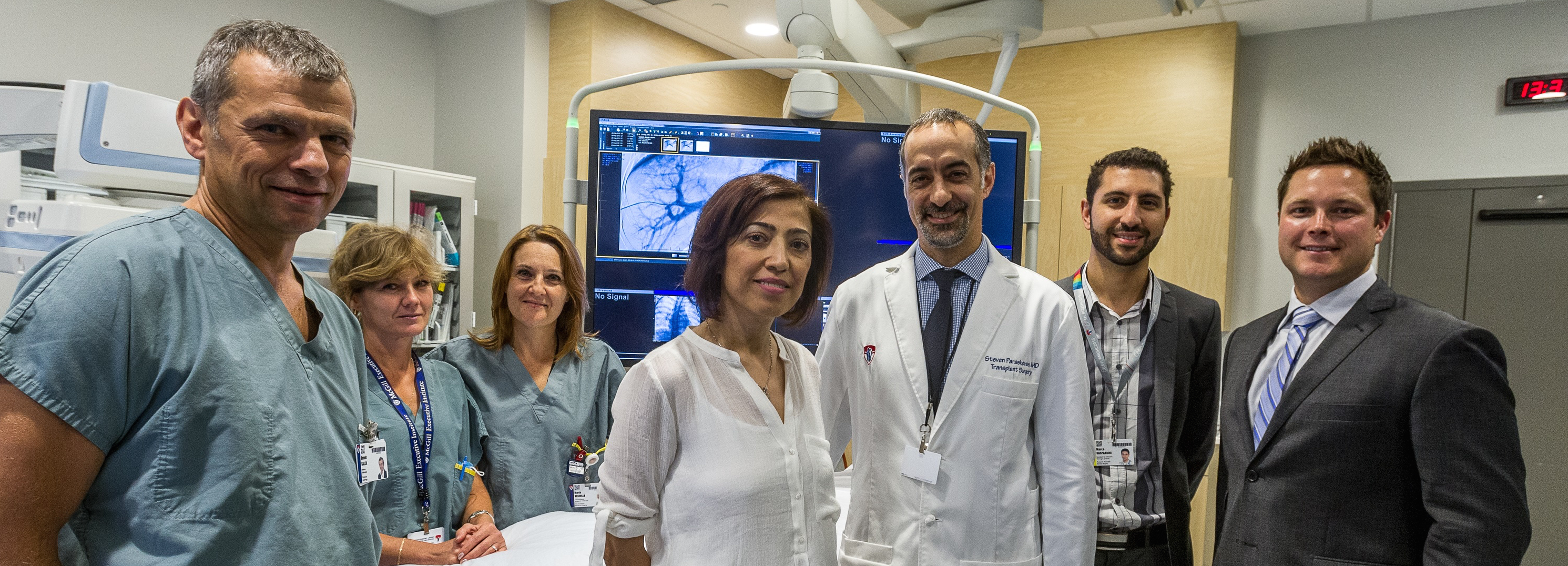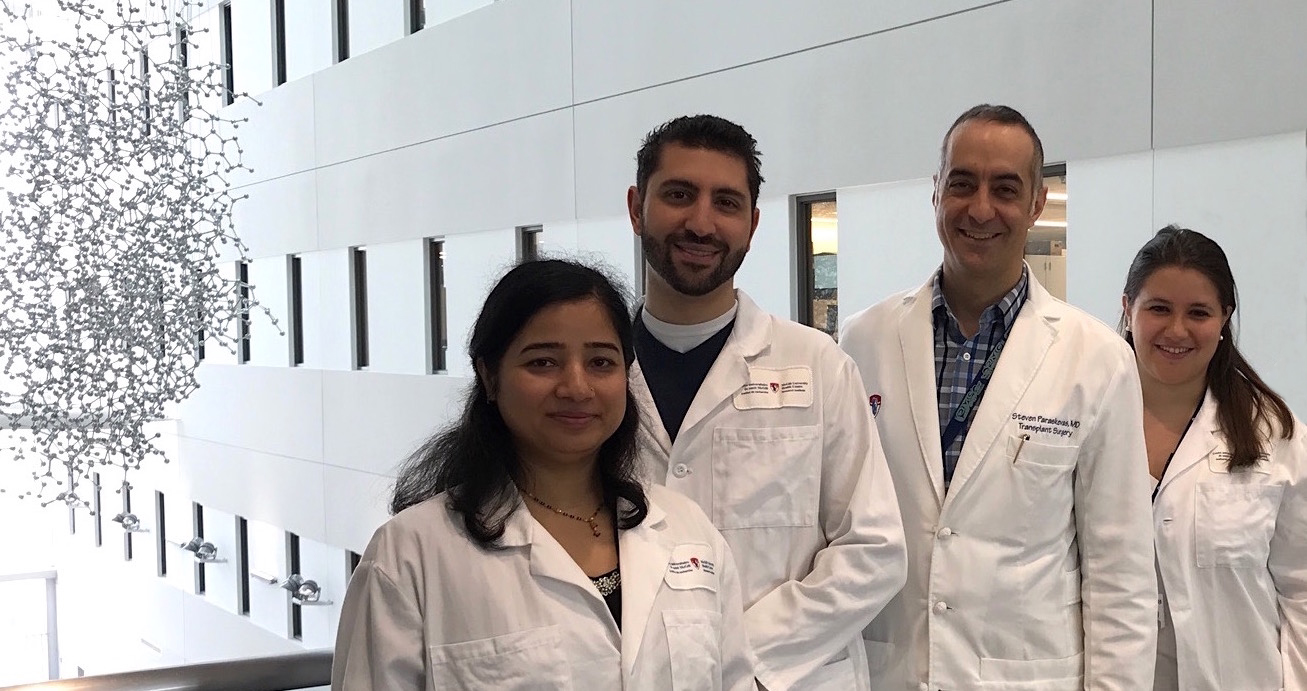News
MUHC designated first provincial establishment for islet cell transplants for patients with type 1 diabetes
Non-invasive procedure allows patients tolive without fear of severe hypoglycemia and even without insulin injections.
Montreal, June 30, 2022 – The McGill University Health Centre (MUHC) is proud to announce its official designation, by the Ministry of Health and Social Services (MSSS), as the first establishment in the province to offer islet cell transplants – a
non-invasive procedure that is a significant advancement in the treatment of type 1 diabetes. The MUHC has been the leader in the development of this unique medical expertise in Quebec, thanks to the dedicated work of research and clinical teams.
Type 1 diabetes results from the inability of the pancreas to produce enough insulin, which can lead to a significant disruption of blood sugar regulation in the body. The disease requires lifelong monitoring of blood sugar and daily insulin injections to prevent serious long-term complications, such as blindness, stroke, kidney failure and cardiovascular disease. The islet cell transplant corrects this condition in severely ill patients. An estimated 300,000 Canadians live with type 1 diabetes.
In 2015, the MUHC conducted the first islet cell transplant in Quebec, a procedure in which islets of Langerhans – the clusters of pancreatic cells that produce insulin – are isolated from a donor’s pancreas and infused into a patient’s liver through a small catheter in the abdomen. After only a few weeks, the patient is able to produce insulin and eventually, becomes insulin independent.
Dr. Steven Paraskevas, director of the MUHC Pancreas and Islet Transplantation Program, heads the MUHC Human Islet Transplantation Laboratory, where islets are isolated and evaluated. The knowledge and expertise developed in this laboratory paves the way for the work of other clinicians.
“The growth and development of this program has been a success story of collaboration between many researchers and medical professionals, supported by the vision and leadership of the MUHC,” says Dr. Paraskevas. “We would also like to acknowledge the precious contribution of the MUHC Foundation and the Montreal General Hospital Foundation, whose donations enabled us to develop this program and be officially designated as the hospital to offer this procedure for Quebec.”
An expansion of care
Since the first procedure, the MUHC team led by Dr. Paraskevas continued to develop its medical expertise at the MUHC Human Islet Transplant Laboratory, located at McGill University. Ten transplants have been performed and their effects have been carefully studied. The new designation will allow the MUHC to improve access to this procedure and to be able to treat many more individuals. “We are so proud that after years of work and persistence, the MUHC will be able to continue providing this life-altering therapy,” says Dr. Liane Feldman, MUHC Surgeon-in-chief. “This procedure makes a significant difference in the lives of diabetic patients. Our goal is to grow the program so that more Quebecers can benefit in the years to come.”
Support for the development of this clinical program was provided by the McGill University Health Centre Foundation, the Montreal General Hospital Foundation, the Research Institute of the MUHC, Transplant Quebec and the Canada Foundation for Innovation. https://muhc.ca/news-and-patient-stories/muhc-designated-first-provincia...
________________
Publication de l'avis Transplantation des îlots de Langerhans chez les personnes atteintes d’un diabète de type 1 instable
Dans cet avis, l'INESSS (Institut national d'excellence en santé et services sociaux) a évalué la pertinence d’introduire la transplantation allogénique d’îlots de Langerhans (TIL) parmi la gamme des traitements offerts aux patients atteints d’un diabète de type 1. Plusieurs recommandations ont été émises après avoir considéré l’efficacité et l’innocuité de la TIL, la perspective des patients, les données économiques ainsi que les considérations éthiques.
Une fiche synthèse accompagne également cette publication.
Tous les documents sont disponibles dans le section Publications du site Web de l'INESSS.
________________
L'espoir d'une greffe de cellules du pancréas
(Gaspé) Le Gaspésien Guy-Martin Couture, atteint d'un diabète sévère, vit 24 heures sur 24 avec en tête une donnée : son taux de sucre dans le sang. Malgré sa pompe à insuline et une diète draconienne, ses épisodes d'hypoglycémie deviennent de plus en plus fréquents. L'homme de 48 ans, père de trois enfants, attend une greffe de cellules du pancréas. L'opération menée à Montréal depuis 2015 pourrait lui rendre sa qualité de vie.
Depuis l'âge de 12 ans, M. Couture est atteint du diabète de type 1. Une maladie chronique qui ne se prévient pas, nécessite des injections quotidiennes d'insuline et peut entraîner de graves effets secondaires. «Depuis 36 ans, les hôpitaux de Gaspé à Montréal, je les connais presque tous», dit-il.
M. Couture a perdu la vue d'un oeil, puis de l'autre, et l'a retrouvée grâce à des chirurgies. Il a été sous dialyse pendant six ans avant de recevoir une greffe de rein en 2003.
L'homme natif de Percé suit une diète draconienne pour contrôler son diabète et protéger son rein greffé. «Je ne mange pas de poissons, pas de fruits de mer. C'est dur pour un Gaspésien! Je prends le moins de sel possible. Je n'ai pas bu d'alcool depuis 20 ans.»
Il y a six ans, l'achat d'une pompe à insuline a d'abord amélioré sa situation. Cette machine qu'il porte sur lui mesure en tout temps son taux de sucre et injecte l'insuline nécessaire.
Sauf que, depuis décembre, sa pompe connaît des ratés. Ses mesures de glycémie sont inexactes et la pompe sonne l'alarme sans raison, ou encore omet de sonner.
«Ma pompe peut me réveiller jusqu'à sept fois par nuit. Je peux compter sur les doigts d'une main les nuits où j'ai bien dormi depuis décembre [...]. Moins on dort, plus la glycémie est difficile à contrôler. Je suis dans un cercle vicieux.»
Ses épisodes d'hypoglycémie sont de plus en plus fréquents. «Je deviens amorphe, confus, je manque de concentration.» Il y a un mois, ses collègues de travail ont dû appeler les ambulanciers pour lui porter secours.
M. Couture est directeur des opérations fixes chez Mauger Ford, un concessionnaire automobile. Une semaine sur deux, il conduit de sa résidence de Rimouski à son bureau de Gaspé. Sur la route, il appelle ses collègues à intervalles réguliers pour les rassurer sur son état.
Sa maladie a aussi un coût : ses besoins en médicaments et en matériel se chiffrent à 28 000 $ par an, dont il paie 13 000 $ de sa poche.
Candidat idéal
M. Couture entrevoit un espoir. En mai 2016, il a rencontré une équipe du Centre universitaire de santé McGill (CUSM), qui pratique des greffes d'îlots pancréatiques, la partie de l'organe qui produit l'insuline.
On lui a dit qu'il était un «candidat idéal», notamment parce qu'il prend déjà des médicaments antirejet pour son rein et que son taux de sucre est hors de contrôle.
M. Couture est premier sur la liste des receveurs du groupe sanguin O négatif. Mais les transplantations sont rares. Le CUSM en a pratiqué une en 2015 et une seconde en 2016. Le laboratoire où sont préparées les cellules du pancréas fonctionne grâce à des dons à l'hôpital, ce qui limite ses activités.
Pour maximiser ses chances, le Gaspésien tente d'être inscrit sur la liste des receveurs de pancréas complet. Ce type de greffe se pratique de 10 à 20 fois par an au Québec. M. Couture a aussi pris contact avec l'hôpital de l'Université de l'Alberta, à Edmonton, qui greffe des îlots pancréatiques à 30 à 40 patients par an.
S'il parle au Soleil, c'est pour sensibiliser la population aux impacts de sa maladie. «Le diabète augmente quand les gens sont plus sédentaires. Je veux sensibiliser les jeunes qui "pitonnent" à la place d'aller jouer dehors.»
M. Couture s'aperçoit que le personnel de la santé est de plus en plus débordé. Il presse le gouvernement d'accorder les ressources nécessaires au système.
L'homme veut aussi que «les gens pensent au don d'organes. C'est un don de vie. Sur un cadavre, on prend les reins, le foie, le pancréas, les yeux... Ça peut sauver cinq ou six vies».
Greffe d'îlots : comment ça marche?
Les cellules productrices d'insuline, l'hormone qui contrôle le taux de sucre, représentent 1 % du volume du pancréas.
Dans un laboratoire spécialisé du Centre universitaire de santé McGill (CUSM), à Montréal, une équipe isole ces amas de cellules, les «îlots», du pancréas d'un donneur. Elles sont ensuite injectées dans la veine porte du foie du receveur à l'aide d'un cathéter.
Elles se greffent au foie, survivent et se mettent à produire de l'insuline. L'intervention dure de 30 à 45 minutes et se pratique sous anesthésie locale, tandis qu'une greffe de pancréas complet nécessite une chirurgie de quatre à cinq heures, avec une grande incision sur l'abdomen, un long séjour à l'hôpital et des risques de complications.
Le CUSM compte le seul laboratoire dans l'est du Canada qui produit des îlots pancréatiques. Les deux patients transplantés en 2015 et en 2016 ont pu se passer complètement d'insuline après une seule greffe.
«Dans les grands centres américains [où la greffe se pratique], 50 % à 80 % des greffés n'ont plus besoin d'insuline après cinq ans», indique le Dr Steven Paraskevas, chirurgien de greffe et responsable du programme au CUSM.
«Dans les prochaines années, on veut faire plus de greffes, dit-il. On veut que ça devienne une thérapie établie pour tous les gens du Québec qui sont candidats à ça.»
Source: Geneviève Gélinas, LeSoleil
________________
MUHC Conducts first islet cell transplant in quebec
Innovative treatment for type 1 diabetes marks first step towards vision of regional network for islet cell isolation and transplant
July 23, 2015
The MUHC has conducted the first islet cell transplant in Quebec. The breakthrough was made at the Glen site of the MUHC after the complex process of isolating islet cells from a donor pancreas was achieved at the MUHC Human Islet Transplant Laboratory. The procedure, which does not require surgery and reduces hospital stays ten-fold, is a significant advancement in the treatment of type 1 diabetes, and marks the first step in what researchers hope will be the development of a regional network for this novel therapy.
Type 1 diabetes (T1D), sometimes referred to as autoimmune or juvenile diabetes, results from the pancreas' failure to produce enough insulin, causing disruption to blood sugar regulation in the body. The disease cannot be prevented and requires lifelong monitoring of blood sugar, and daily insulin injections, in order to prevent serious long-term complications, such as blindness, stroke, kidney failure and cardiovascular disease.
“For some patients, pancreas transplantation maybe an option, but there are significant risks, and the surgery often involves specialized care in the ICU (Intensive Care Unit) and a hospital stay that could be as long as a month,” says Dr. Steven Paraskevas, Director of the Pancreas and Islet Transplant Program at the MUHC. The infusion of islets – the clusters of pancreatic cells that produce insulin – is a non-surgical technique that is being explored in some academic medical centres as an alternative to the transplantation of the whole pancreas organ.
“As the procedure is minimally invasive, it represents an incredible improvement for patients, as well as the healthcare system, through reductions in risk and infection rates, improved recovery time, and hospital stays measured in hours to days, rather than weeks,” says Dr. Paraskevas, who is also an Associate Professor of Surgery at McGill University.
For patient, Zohra Nabbus, from Pointe Claire, Quebec, life with type 1 diabetes had become increasingly challenging. After kidney transplantation and unsuccessful pancreas transplantation, she was suffering more frequent episodes of hypoglycemia. “It had got to point where I couldn’t be left alone anymore, so when I heard that islet cell transplant had been developed at the MUHC, there was no doubt in my mind that I wanted to be a candidate,” she said.
The procedure began in May at the Human Islet Transplant Laboratory where islet cells were separated from a suitable donor pancreas – a delicate process that has required years of investment in technology and medical expertise. Two days later, the isolated islets were infused into the patient’s liver through a small catheter in the abdomen, without the need for surgery. The entire procedure was conducted in the interventional radiology suite at the Glen site of the MUHC.
“Once the cells were transfused into the liver, we monitored the patient and waited,” says Dr. Benoit Gallix, Director of Radiology at the MUHC and Chair of the Department of Diagnostic Radiology at McGill University, who conducted the procedure with MUHC radiologist Dr. Tatiana Cabrera, who is also an Assistant Professor at McGill. “Within a few days the patient began producing insulin on her own, and after several weeks she was completely insulin independent – the entire procedure could not have gone better.”
Additionally, the entire process only required one infusion, rather than the two or three that the researchers had expected. “Our team advanced the established protocol by using a Giner Portable Pancreas Persufflation™ System – a new piece of technology that keeps the pancreas oxygenated after it is recovered from the donor and before the islets are isolated,” says Craig Hasilo, Manager of the Human Islet Transplant Laboratory. “We believe this resulted in better quality cells being transplanted, thereby reducing the need for multiple infusions.”
Life has changed rapidly for Zohra Nabbus. “After living with type 1 diabetes for 35 years, it’s hard to get out of the habit of planning your meals, monitoring your blood sugar, and preparing your insulin, but finally I can,” she said. “I have more freedom and flexibility to live my life and I feel much more secure.”
The MUHC has been developing the expertise to conduct this procedure for the past decade, and is the only centre in eastern Canada, and one of only a dozen in North America, capable of isolating and transplanting human islet cells. “Our vision is to establish a network, where islet cells are processed at our institution for infusion at healthcare facilities across the region,” says Dr. Paraskevas. “Quebec is the perfect place to build a network such as this because of our higher than average donor rates.”
“Transplant Québec welcomes the experienced team at MUHC, led by Dr Steven Paraskevas, and is delighted that Quebec can count on the Human Islet Transplant Laboratory in providing innovative treatment to patients whose health and quality of life will be greatly improved. We will continue to be at the forefront to support the work of the Laboratory as we have done in the research phase. This collaboration is at the heart of the mission of Transplant Québec, which coordinates organ donation in the province of Quebec,” acknowledged Louis Beaulieu, CEO of Transplant Québec.
Islet cell transplantation is currently considered a novel therapy in Canada, and has been assessed for expanded use by the MUHC’s Technology Assessment Unit (TAU), as well as the FDA (Food and Drug Administration) for approval in the United States. The procedure is already a recognized therapy for diabetes in the UK and Europe. There are approximately three million people afflicted with diabetes in Canada, over 300,000 of which have type 1 diabetes.
Support for this project was provided by The Royal Victoria Hospital Foundation, The Montreal General Hospital Foundation, the Research Institute of the MUHC, Transplant Quebec and the Canada Foundation for Innovation. Please help us in providing this procedure to others by donating to our cause to the MUHC Foundation: http://www.isletlab.org/donate.
UPCOMING
Sorry, there are no posts at this time.



